It was 1642 and Abel Tasman was on a mission. The experienced Dutch sailor, who sported a flamboyant moustache, bushy goatee and penchant for rough justice – he later tried to hang some of his crew on a drunken whim – was confident of the existence of a vast continent in the southern hemisphere, and determined to find it.
At the time, this portion of the globe was still largely mysterious to Europeans, but they had an unshakeable belief that there must be a large land mass there – pre-emptively named Terra Australis – to balance out their own continent in the North. The fixation dated back to Ancient Roman times, but only now was it going to be tested.
And so, on 14 August, Tasman set sail from his company’s base in Jakarta, Indonesia, with two small ships and headed west, then south, then east, eventually ending up at the South Island of New Zealand. His first encounter with the local Māori people (who are thought to have settled there several centuries earlier) did not go well: on day two, several paddled out on a canoe, and rammed a small boat that was passing messages between the Dutch ships. Four Europeans died. Later, the Europeans fired a cannon at 11 more canoes – it’s not known what happened to their targets.
And that was the end of his mission – Tasman named the fateful location Moordenaers (Murderers) Bay, with little sense of irony, and sailed home several weeks later without even having set foot on this new land. While he believed that he had indeed discovered the great southern continent, evidently, it was hardly the commercial utopia he had envisaged. He did not return.
(By this time, Australia was already known about, but the Europeans thought it was not the legendary continent they were looking for. Later, it was named after Terra Australis when they changed their minds).
Little did Tasman know, he was right all along. There was a missing continent.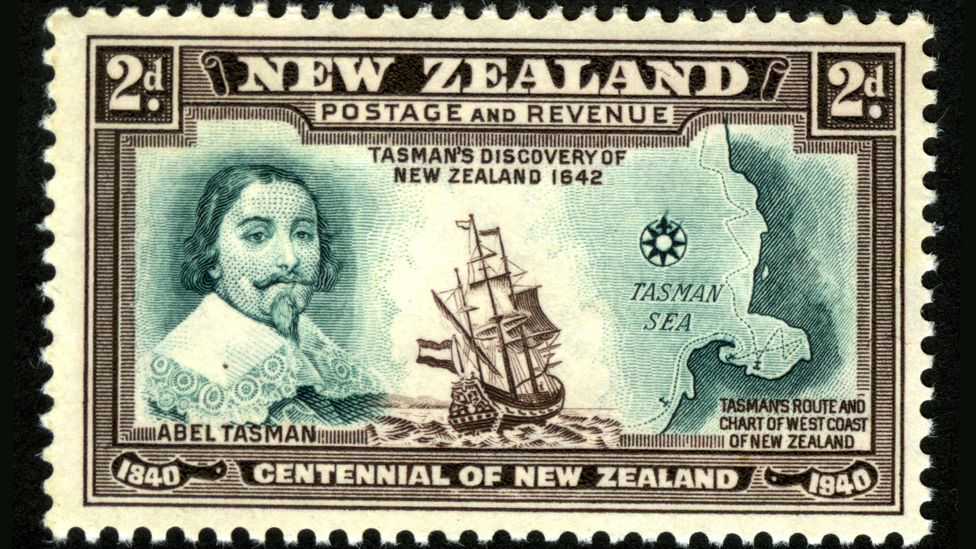
Abel Tasman arguably did find the great southern continent, though he didn’t realise 94% of it is underwater (Credit: Alamy)
In 2017, a group of geologists hit the headlines when they announced their discovery of Zealandia –Te Riu-a-Māui in the Māori language. A vast continent of 1.89 million sq miles (4.9 million sq km) it is around six times the size of Madagascar.
Though the world’s encyclopaedias, maps and search engines had been adamant that there are just seven continents for some time, the team confidently informed the world that this was wrong. There are eight after all – and the latest addition breaks all the records, as the smallest, thinnest, and youngest in the world. The catch is that 94% of it is underwater, with just a handful of islands, such as New Zealand, thrusting out from its oceanic depths. It had been hiding in plain sight all along.
“This is an example of how something very obvious can take a while to uncover,” says Andy Tulloch, a geologist at the New Zealand Crown Research Institute GNS Science, who was part of the team that discovered Zealandia.
But this is just the beginning. Four years on and the continent is as enigmatic as ever, its secrets jealously guarded beneath 6,560 ft (2km) of water. How was it formed? What used to live there? And how long has it been underwater?
A laborious discovery
In fact, Zealandia has always been difficult to study.
More than a century after Tasman discovered New Zealand in 1642, the British map-maker James Cook was sent on a scientific voyage to the southern hemisphere. His official instructions were to observe the passing of Venus between the Earth and the Sun, in order to calculate how far away the Sun is.
Possibly due to a quirk of geology, the enigmatic kiwi bird’s closest relative hails from Madagascar (Credit: Alamy)
But he also carried with him a sealed envelope, which he was instructed to open when he had completed the first task. This contained a top-secret mission to discover the southern continent – which he arguably sailed straight over, before reaching New Zealand.
The first real clues of Zealandia’s existence were gathered by the Scottish naturalist Sir James Hector, who attended a voyage to survey a series of islands off the southern coast of New Zealand in 1895. After studying their geology, he concluded that New Zealand is “the remnant of a mountain-chain that formed the crest of a great continental area that stretched far to the south and east, and which is now submerged…”.
Despite this early breakthrough, the knowledge of a possible Zealandia remained obscure, and very little happened until the 1960s. “Things happen pretty slowly in this field,” says Nick Mortimer, a geologist at GNS Science who led the 2017 study.
Then in the 1960s, geologists finally agreed on a definition of what a continent is – broadly, a geological area with a high elevation, wide variety of rocks, and a thick crust. It also has to be big. “You just can’t be a tiny piece,” says Mortimer. This gave geologists something to work with – if they could collect the evidence, they could prove that the eighth continent was real.
Still, the mission stalled – discovering a continent is tricky and expensive, and Mortimer points out that there was no urgency. Then in 1995, the American geophysicist Bruce Luyendyk again described the region as a continent and suggested calling it Zealandia. From there, Tulloch describes its discovery as an exponential curve.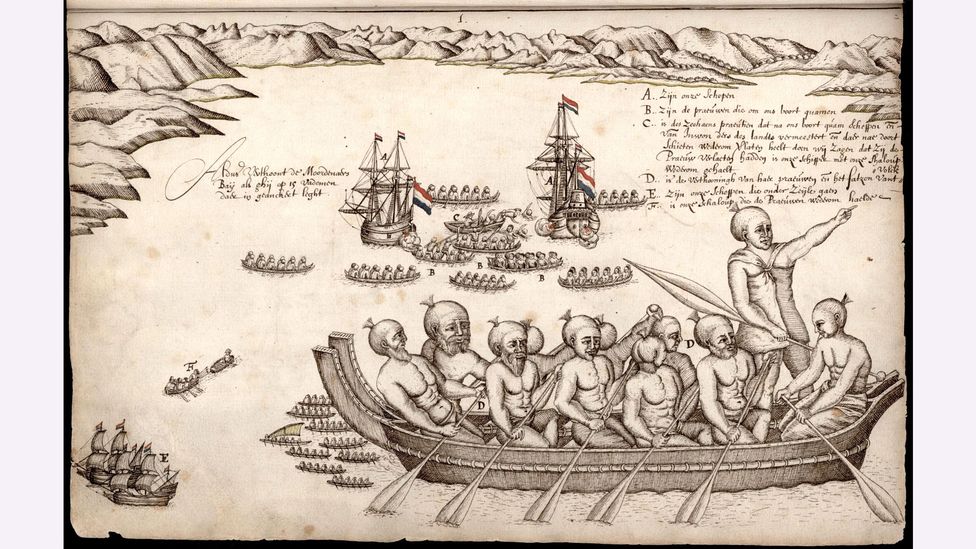
Tasman’s ships left New Zealand after a bloody encounter with the Māori people – but he believed that he had found the legendary southern continent (Credit: Alamy)
Around the same time, the “United Nations Convention on the Law of the Sea” came into force, and finally provided some serious motivation. It states that countries can extend their legal territories beyond their Exclusive Economic Zone, which reaches 200 nautical miles (370km) out from their coastlines, to claim their “extended continental shelf” – with all the mineral riches and oil this encompasses.
If New Zealand could prove that it was part of a larger continent, it could increase its territory by six times. Suddenly there was an abundance of funding for trips to survey the area, and the evidence gradually built up. With every rock sample that was collected, the case for Zealandia improved.
The final flourish came from satellite data, which can be used to track tiny variations in the Earth’s gravity across different parts of the crust to map the seafloor. With this technology, Zealandia is clearly visible as a misshapen mass almost as large as Australia. 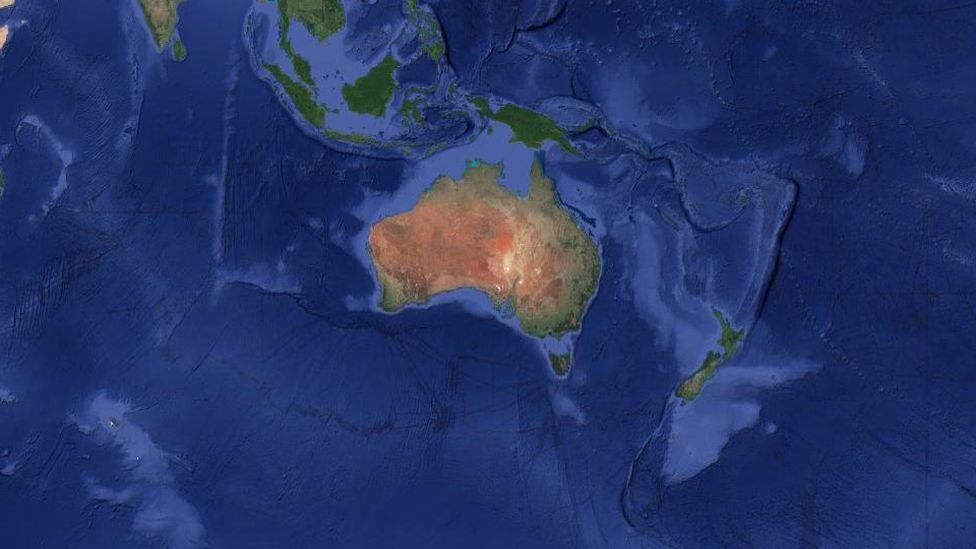
Satellite data can be used to visualise the continent of Zealandia, which appears as a pale blue upside-down triangle to the east of Australia (Credit: GNS Science)
When the continent was finally unveiled to the world, it unlocked one of the most sizeable maritime territories in the world. “It is kind of cool,” says Mortimer, “If you think about it, every continent on the planet has different countries on it, [but] there are only three territories on Zealandia.”
In addition to New Zealand, the continent encompasses the island of New Caledonia – a French colony famous for its dazzling lagoons – and the tiny Australian territories of Lord Howe Island and Ball’s Pyramid. The latter was described by one 18th-Century explorer as appearing “not to be larger than a boat.”
A mysterious stretching
Zealandia was originally part of the ancient supercontinent of Gondwana, which was formed about 550 million years ago and essentially lumped together all the land in the southern hemisphere. It occupied a corner on the eastern side, where it bordered several others, including half of West Antarctica and all of eastern Australia.
Then around 105 million years ago, “due to a process which we don’t completely understand yet, Zealandia started to be pulled away”, says Tulloch.
Continental crust is usually around 40km deep – significantly thicker than oceanic crust, which tends to be around 10km. As it was strained, Zealandia ended up being stretched so much that its crust now only extends 20km (12.4 miles) down. Eventually, the wafter-thin continent sank – though not quite to the level of normal oceanic crust – and disappeared under the sea.
Despite being thin and submerged, geologists know that Zealandia is a continent because of the kinds of rocks found there. Continental crust tends to be made up of igneous, metamorphic and sedimentary rocks – like granite, schist and limestone, while the ocean floor is usually just made of igneous ones such as basalt.
When the supercontinent of Gondwana broke up, fragments drifted all across the globe. Many of its ancient plants still live in the Australian Dorrigo forest (Credit: Getty Images)
But there are still many unknowns. The unusual origins of the eighth continent make it particularly intriguing to geologists, and more than a little baffling. For example, it’s still not clear how Zealandia managed to stay together when it’s so thin and not disintegrate into tiny micro-continents.
Another mystery is exactly when Zealandia ended up underwater – and whether it has ever, in fact, consisted of dry land. The parts that are currently above sea level are ridges that formed as the Pacific and Australian tectonic plates crumpled together. Tulloch says opinion is split as to whether it was always submerged apart from a few small islands, or once entirely dry land.
This also raises the question of what lived there.
With its mild climate and 39 million-sq-mile (101 million-sq-km) range, Gondwana itself was home to a vast array of flora and fauna, including the first four-limbed land animals and later, an abundance of the largest to ever live – the titanosaurs. So, could the rocks of Zealandia be studded with their preserved remains?
A debate about dinosaurs
Fossilised land animals are rare in the southern hemisphere, but the remains of several were found in New Zealand in the 1990s, including the rib bone of a giant, long-tailed, long-necked dinosaur (a sauropod), a beaky herbivorous dinosaur (a hypsilophodont) and an armoured dinosaur (an ankylosaur). Then in 2006, the foot bone of a large carnivore, possibly a kind of allosaur, was discovered in the Chatham Islands, about 500 miles (800km) east of the South Island. Crucially, the fossils all date to after the continent of Zealandia split from Gondwana.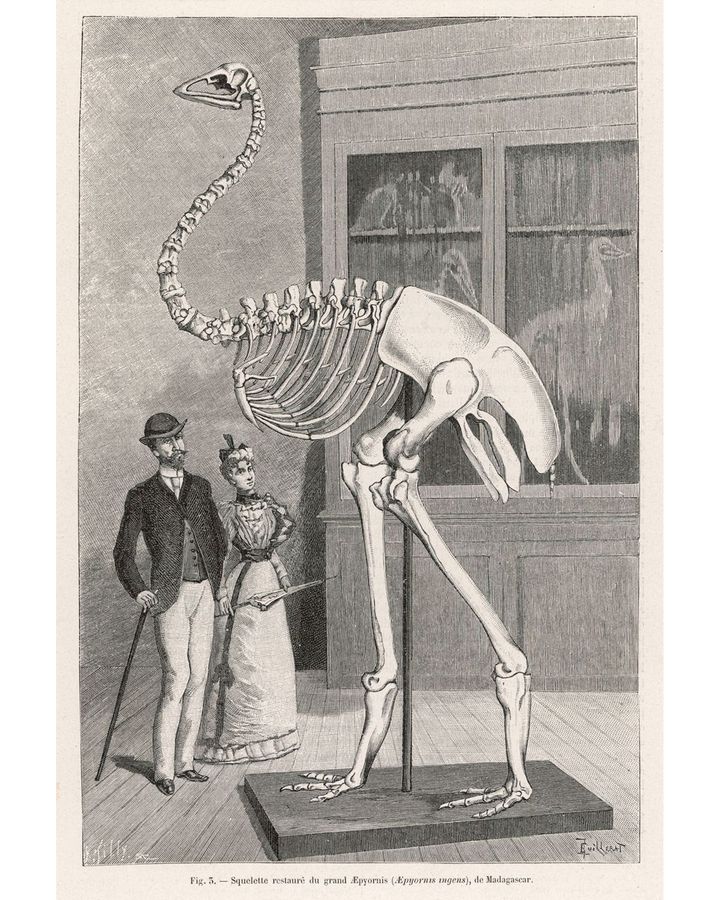
The elephant bird stood 3 m (9.8 ft) tall and fragments of its eggshells still litter beaches to this day (Credit: Alamy)
However, this doesn’t necessarily mean there were dinosaurs roaming over the majority of Zealandia – these islands may have been sanctuaries while the rest was drowned, as it is now. “There’s a long debate about this, about whether it’s possible to have land animals without continuous land – and whether without it, they would have been snuffed out,” says Rupert Sutherland, a Professor of Geophysics and Tectonics at the Victoria University of Wellington.
The plot thickens with one of New Zealand’s weirdest and most beloved inhabitants, the kiwi – a dumpy, flightless bird with whiskers and hair-like feathers. Oddly, its closest relative is not thought to be the Moa, which is part of the same group – the ratites – and lived on the same island until its extinction 500 years ago, but the even-more giant elephant bird, which stalked the forests of Madagascar until as recently as 800 years ago.
The finding has led scientists to believe that both birds evolved from a common ancestor that lived on Gondwana. It took 130 million years to fully break up, but when it did, it left behind fragments which have since been scattered all across the globe, forming South America, Africa, Madagascar, Antarctica, Australia, the Arabian Peninsula, the Indian Subcontinent, and Zealandia.
This, in turn, suggests that at least part of now-submerged Zealandia has remained above sea level the whole time. Except around 25 million years ago the entire continent – even possibly the entirety of New Zealand – is thought to have been plunged underwater. “It was thought that all the plants and animals must have colonised afterwards,” says Sutherland. So what happened?
New Zealand is one of the highest points of Zealandia, after being pushed up by the movement of tectonic plates (Credit: Alamy)
Though it’s not possible to collect fossils from the seafloor of Zealandia directly, scientists have been plumbing its depths by drilling. “Actually the most helpful and distinctive fossils are the ones which form in the very shallow seas,” says Sutherland. “Because they leave a record – there are zillions and zillions of tiny, tiny little fossils that are very distinctive.”
In 2017, a team undertook the most extensive surveys of the region so far, and drilled more than 4,101ft (1,250m) into the seabed at six different sites. The cores that they collected contained pollen from land plants, as well as spores and the shells of organisms that lived in warm, shallow seas.
“If you have water, which is only you know, 10m (33ft) deep or something like this, then there’s a good chance that there was land around as well,” says Sutherland, who explains that the pollen and spores also hint at the possibility that Zealandia was not quite as submerged as was thought.
A (literal) twist
Another lingering mystery can be found in Zealandia’s shape.
“If you look at a geological map of New Zealand, there are two things that really stand out,” says Sutherland. One of these is Alpine Fault, a plate boundary that runs along the South Island and is so significant, it can be seen from space.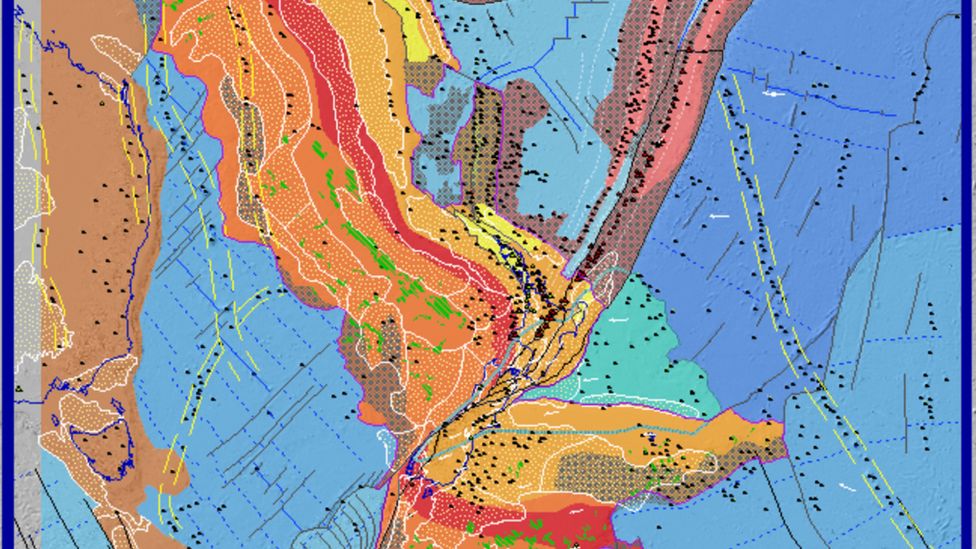
The red band of rock – the Median Batholith – should travel all the way down Zealandia in a diagonal line, but instead it has been twisted out of shape (Credit: GNS Science)
The second is that the geology of New Zealand – as well as that of the wider continent – is oddly bent. Both are split in two by a horizontal line, which is where the Pacific and Australian tectonic plates meet. At this exact point, it looks like someone has taken the lower half and twisted it away, so that not only do the previously-continuous ribbons of rock no longer line up, but they are almost at right angles.
An easy explanation for this is that the tectonic plates moved, and somehow deformed them out of shape. But exactly how or when this happened is still totally unresolved.
“There are various interpretations, but this is quite a large unknown thing,” says Tulloch.
Sutherland explains that the continent is unlikely to give up all its secrets anytime soon. “It’s quite hard to make discoveries, when everything is 2km (1.2 miles) underwater, and the layers that you need to sample are 500m (1,640ft) beneath the seabed as well,” he says. “It’s really challenging to go out and explore a continent like that. So, it just takes a lot of time, money and effort to go out and ships and survey regions.”
If nothing else, the world’s eighth continent surely shows that – nearly 400 years after Tasman’s quest – there is still plenty to be discovered.
DISCLAIMER: The Views, Comments, Opinions, Contributions and Statements made by Readers and Contributors on this platform do not necessarily represent the views or policy of Multimedia Group Limited.
- President Commissions 36.5 Million Dollars Hospital In The Tain District
- You Will Not Go Free For Killing An Hard Working MP – Akufo-Addo To MP’s Killer
- I Will Lead You To Victory – Ato Forson Assures NDC Supporters
Visit Our Social Media for More




